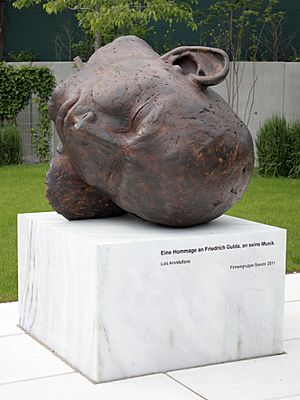Friedrich Gulda facts for kids
Quick facts for kids
Friedrich Gulda
|
|
|---|---|

A statue of Friedrich Gulda.
|
|
| Born | 16 May 1930 Vienna, Austria
|
| Died | 27 January 2000 (aged 69) Steinbach am Attersee, Austria
|
| Education |
|
| Occupation |
|
| Awards | Austrian Cross of Honour for Science and Art |
Friedrich Gulda (born May 16, 1930 – died January 27, 2000) was an amazing Austrian musician. He was a talented pianist and composer. What made him special was that he played and wrote music in both classical and jazz styles.
Contents
Friedrich Gulda's Early Life
Friedrich Gulda was born in Vienna, Austria. His father was a teacher. Friedrich started playing the piano when he was just seven years old. He learned at the Wiener Volkskonservatorium. Later, in 1942, he went to the Vienna Music Academy. There, he studied piano and music theory.
During World War II, when he was a teenager, Gulda and his friend Joe Zawinul did something brave. They played jazz music, even though the government had forbidden it.
In 1946, Gulda won first prize at the Geneva International Music Competition. This was a big achievement for him. After this, he started playing concerts all over the world. His first performance in Carnegie Hall in New York City was in 1950. Gulda, along with Jörg Demus and Paul Badura-Skoda, became known as the "Viennese troika." This means they were a famous group of three pianists from Vienna.
Playing Classical Music
Friedrich Gulda was very famous for playing the music of Mozart and Beethoven. But he also played pieces by other great composers. These included J. S. Bach, Schubert, Chopin, Schumann, Debussy, and Ravel.
He recorded Bach's The Well-Tempered Clavier, which is a very well-known set of pieces. Gulda continued to perform classical music throughout his life. He even wrote his own special parts, called cadenzas, for two of Mozart's concertos. He recorded these with his former student, Claudio Abbado. Gulda often added his own musical ideas and improvisations to Mozart's pieces.
In 1999, a special CD collection called Great Pianists of the 20th Century included Gulda's work. Many famous pianists were his students, including Martha Argerich. She said he was her "most important influence."
Exploring Jazz and New Music
In 1956, Gulda started exploring jazz music. He performed and recorded at famous jazz clubs like Birdland in New York City. He also played at the Newport Jazz Festival.
Gulda loved jazz because it had "rhythmic drive" and was a big contrast to the strict classical training he had received. He even learned to play the baritone saxophone. He also organized a competition for modern jazz in 1966. In 1968, he started a school called International Musikforum. This school helped students learn how to improvise music.
Gulda also wrote his own music. In the 1960s, he wrote a Prelude and Fugue that sounded like swing jazz. The famous musician Keith Emerson liked it so much that his band, Emerson, Lake & Palmer, often played it in their concerts.
Gulda also composed "Variations on The Doors' 'Light My Fire'" for solo piano. He released this in 1971. He also recorded jazz standards like "'Round Midnight" and "What Is This Thing Called Love?"
From the late 1960s to the 1980s, Gulda continued to play both classical and jazz music. He also experimented with "free improvisation." This is a type of music where musicians make up the music as they go along, without a set plan. He played with many musicians who were also interested in this style. Gulda believed that all music had value, no matter how people judged it.
In the late 1970s and 1980s, Gulda was part of yearly music festivals. Famous musicians like Herbie Hancock, Joe Zawinul, and Chick Corea came to perform with him.
In 1980, he wrote a special piece called Concerto for Cello and Wind Orchestra. It has five parts and mixes jazz, rock, and classical music. It even has parts where the cello player has to improvise!
In 1982, Gulda worked with jazz pianist Chick Corea. They recorded an album called The Meeting. On this album, they played long improvisations that mixed jazz and classical music. They also played Mozart's Double Piano Concerto together.
Later Years and Personality
In 1988, Gulda cancelled a performance at the Salzburg Festival. This happened because the festival organizers did not want his jazz musician friend Joe Zawinul to perform with him.
The Vienna Music Academy gave him an award called the Beethoven Ring. Gulda accepted it, but then later gave it back. He was known for being a bit rebellious and doing things his own way.
In 1999, to promote a concert, he even announced his own death in a press release! This was a joke so that the concert at the Vienna Konzerthaus could be a "resurrection party."
Friedrich Gulda passed away from heart failure on January 27, 2000. He was 69 years old. He is buried in the cemetery of Steinbach am Attersee, Austria. He asked that no obituary (a notice of his death) be published.
Personal Life
Friedrich Gulda was married twice. His first wife was actress Paola Loew. They were married from 1956 to 1966 and had two sons, David Wolfgang and Paul. His second wife was Yuko Wakiyama. They were married from 1967 to 1973 and had another son, Rico. Both Paul and Rico also became talented pianists. From 1975 until his death, Gulda was in a relationship with the singer Ursula Anders.
In 2007, a TV documentary film was made about his life. It was called So what?! – Friedrich Gulda.
Decorations and awards
- 1959: Austrian Cross of Honour for Science and Art
- 1989: Honorary Ring of Vienna
Images for kids
See also
 In Spanish: Friedrich Gulda para niños
In Spanish: Friedrich Gulda para niños


